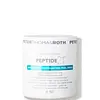What's inside
What's inside
 Key Ingredients
Key Ingredients

 Benefits
Benefits

 Concerns
Concerns

 Ingredients Side-by-side
Ingredients Side-by-side

Oat Amino Acids
Skin ConditioningRetinol
Skin ConditioningWater
Skin ConditioningButylene Glycol
HumectantSodium Lactate
BufferingPhytic Acid
PPG-5-Ceteth-20
EmulsifyingRosa Centifolia Flower Water
Skin ConditioningHamamelis Virginiana Water
AstringentSalicylic Acid
MaskingThreonine
Glutamic Acid
HumectantSerine
MaskingAspartic Acid
MaskingArginine
MaskingAlanine
MaskingProline
Skin ConditioningValine
MaskingHistidine
HumectantGlycine
BufferingLysine
Skin ConditioningChamomilla Recutita Flower Extract
MaskingCamellia Sinensis Leaf Extract
AntimicrobialAscorbic Acid
AntioxidantRetinyl Palmitate
Skin ConditioningTocopheryl Acetate
AntioxidantAloe Barbadensis Leaf Juice
Skin ConditioningBorago Officinalis Seed Oil
EmollientSymphytum Officinale Leaf Extract
Skin ConditioningCitrus Limon Peel Extract
EmollientCitrus Aurantifolia Peel Extract
CleansingCitrus Aurantium Dulcis Fruit Extract
MaskingCitrus Tangerina Peel Extract
AstringentMentha Piperita Extract
CleansingSalvia Officinalis Leaf Extract
CleansingZingiber Officinale Root Extract
MaskingPhenoxyethanol
PreservativeSodium Hydroxide
BufferingAminobutyric Acid
Potassium Sorbate
PreservativeSodium Benzoate
MaskingCaprylic/Capric Triglyceride
MaskingPEG-8 Dimethicone
EmulsifyingLeucine
Skin ConditioningSodium Ascorbyl Phosphate
AntioxidantLimonene
PerfumingBenzoic Acid
MaskingTyrosine
MaskingPhenylalanine
MaskingIsoleucine
Skin ConditioningCitric Acid
BufferingOctyldodecanol
EmollientSilica
AbrasiveSodium Propoxyhydroxypropyl Thiosulfate Silica
Oat Amino Acids, Retinol, Water, Butylene Glycol, Sodium Lactate, Phytic Acid, PPG-5-Ceteth-20, Rosa Centifolia Flower Water, Hamamelis Virginiana Water, Salicylic Acid, Threonine, Glutamic Acid, Serine, Aspartic Acid, Arginine, Alanine, Proline, Valine, Histidine, Glycine, Lysine, Chamomilla Recutita Flower Extract, Camellia Sinensis Leaf Extract, Ascorbic Acid, Retinyl Palmitate, Tocopheryl Acetate, Aloe Barbadensis Leaf Juice, Borago Officinalis Seed Oil, Symphytum Officinale Leaf Extract, Citrus Limon Peel Extract, Citrus Aurantifolia Peel Extract, Citrus Aurantium Dulcis Fruit Extract, Citrus Tangerina Peel Extract, Mentha Piperita Extract, Salvia Officinalis Leaf Extract, Zingiber Officinale Root Extract, Phenoxyethanol, Sodium Hydroxide, Aminobutyric Acid, Potassium Sorbate, Sodium Benzoate, Caprylic/Capric Triglyceride, PEG-8 Dimethicone, Leucine, Sodium Ascorbyl Phosphate, Limonene, Benzoic Acid, Tyrosine, Phenylalanine, Isoleucine, Citric Acid, Octyldodecanol, Silica, Sodium Propoxyhydroxypropyl Thiosulfate Silica
 Reviews
Reviews

Alternatives
Ingredients Explained
These ingredients are found in both products.
Ingredients higher up in an ingredient list are typically present in a larger amount.
Salicylic Acid (also known as beta hydroxy acid or BHA) is a well-known ingredient for treating skin that struggles with acne and clogged pores. It exfoliates both the skin's surface and deep within the pores to help clear out buildup, control oil, and reduce inflammation.
Unlike AHAs (alpha hydroxy acids), salicylic acid is oil-soluble. This allows it to penetrate into pores which makes it especially effective for treating blackheads and preventing future breakouts.
Salicylic acid is also known for its soothing properties. It has a similar structure to aspirin and can calm inflamed or irritated skin, making it a good option for acne-prone skin that is also sensitive.
Concentrations of 0.5-2% are recognized by the U.S. FDA as an over-the-counter topical acne product.
It can cause irritation and/or dryness if one's skin already has a compromised moisture barrier, so it's best to focus on repairing that before introducing this ingredient into your routine.
While salicylic acid does not increase sun sensitivity, it’s still important to wear sunscreen daily to protect your skin.
If you are looking for the ingredient called BHA or Butylated Hydroxyanisole, click here.
Learn more about Salicylic AcidSodium Benzoate is a preservative. It's used in both cosmetic and food products to inhibit the growth of mold and bacteria. It is typically produced synthetically.
Both the US FDA and EU Health Committee have approved the use of sodium benzoate. In the US, levels of 0.1% (of the total product) are allowed.
Sodium benzoate works as a preservative by inhibiting the growth of bacteria inside of cells. It prevents the cell from fermenting a type of sugar using an enzyme called phosphofructokinase.
It is the salt of benzoic acid. Foods containing sodium benzoate include soda, salad dressings, condiments, fruit juices, wines, and snack foods.
Studies for using ascorbic acid and sodium benzoate in cosmetics are lacking, especially in skincare routines with multiple steps.
We always recommend speaking with a professional, such as a dermatologist, if you have any concerns.
Learn more about Sodium BenzoateWater. It's the most common cosmetic ingredient of all. You'll usually see it at the top of ingredient lists, meaning that it makes up the largest part of the product.
So why is it so popular? Water most often acts as a solvent - this means that it helps dissolve other ingredients into the formulation.
You'll also recognize water as that liquid we all need to stay alive. If you see this, drink a glass of water. Stay hydrated!
Learn more about Water